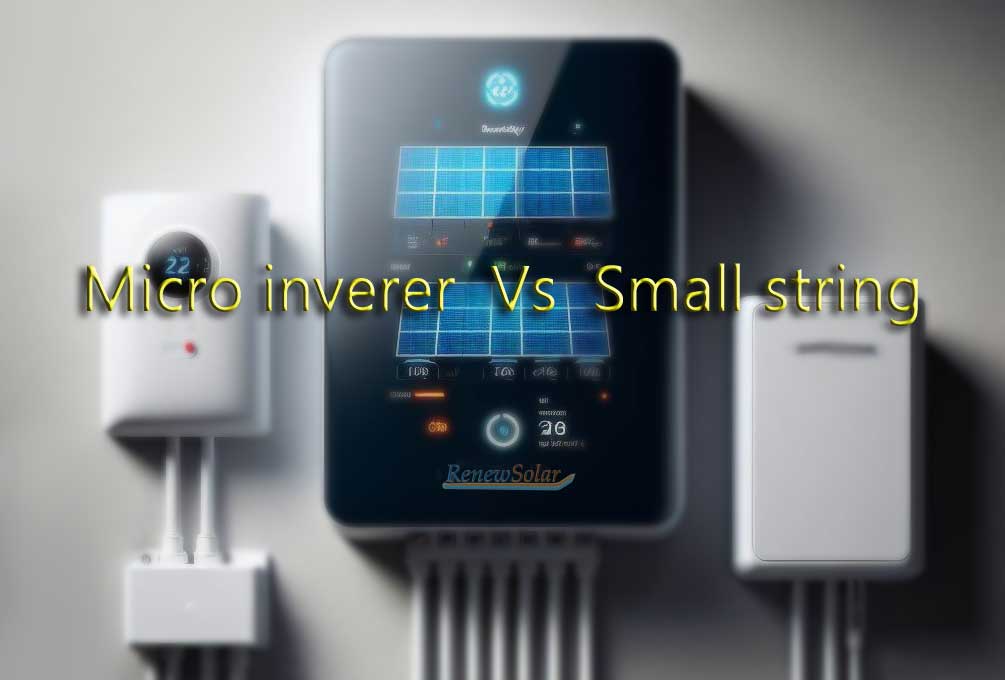Growatt 1000W String Inverter vs. Deye 800W Microinverter
Here’s a breakdown of the key differences and considerations for these two inverter types:
Technology:
- Growatt 1000W String Inverter: This is a traditional string inverter. It connects multiple solar panels in series (a “string”) and converts the combined DC (direct current) output from the panels into AC (alternating current) for your home.
- Deye 800W Microinverter: This is a microinverter. Each microinverter attaches directly to a single solar panel and converts its DC output into AC individually.
Technical Specs:
- Power Output: Growatt (1000W) vs. Deye (800W) – Growatt offers higher overall system power output.
- Maximum Input Voltage: Growatt (450V) vs. Deye (80V) – Growatt allows for longer strings with more panels, potentially increasing winter production due to higher voltage overcoming resistance losses. Deye’s lower voltage limit restricts the number of panels per string but they are not designed as a string inverter.
- MPPT (Maximum Power Point Tracking): Growatt (1) vs. Deye (2) – Deye has two MPPT trackers which can optimize power production for two differently oriented sections of your roof (e.g., east and west facing). Growatt has one MPPT, limiting optimization if your roof has shading variations.
Pros and Cons – Scenarios:
Scenario 1: Simple, South-facing Roof with No Shading
- Growatt: Pros: slightly higher cost, higher total system power output, greater number of panels.
Cons: Less shade tolerance, potential for power loss if one panel underperforms (affects entire string depending on panel bypass). - Deye: Pros: More shade tolerant (each panel optimized), easier future expansion. Cons: lower upfront cost, lower total system power output.
Scenario 2: Complex Roof with Shading or Different Orientations
- Growatt: Cons: String performance limited by worst-performing panel in shade save for bypass diodes.
- Deye: Pros: Microinverters optimize each panel for maximum production despite shading or orientation differences.
Scenario 3: Winter Production
- Growatt: Pros: Higher voltage can overcome some winter-related efficiency losses.
- Deye: Cons: Lower voltage could be more affected by resistance losses in winter.
Additional Considerations:
- Monitoring: Both inverters offer monitoring options, deye can be direct as it has wifi build in. additional (app) monitoring is on a 5 minute interval.
- Installation: String inverters are generally easier to install. Microinverters require more individual connections and installing a AC cable.
- Maintenance: String inverters have one central point of failure. Microinverters isolate any panel issues.
Overall:
The best choice depends on your specific needs. String inverters are simpler and potentially cheaper.. Microinverters offer better shade tolerance, future expandability, and individual panel optimization, but may be at a higher cost. Consider your roof layout, shading, budget, and future expansion plans when making your decision.
Like for like….
If we look at the cost of a 1500w inverter and 2, 800w inverters the (1600w) to give us some comparison the cost of the inverter is higher as you expand the system. with the string inverter it is wise to buy one that is bigger, you can always add panels. you just need to meet the start up voltage which can be between 2 and 3 panels. with the micro inverters they can be smaller and have limited connections, the 800w Deye micro inverter could take four panels due to each mppt being 80volts. but you would be limited to the inverter output which every you chose. but you are buying a micro inverter and panels when you are upgrading.
This is fairly futile and you should take into account that the value is panel voltage in winter when the current from the sun is low. The winner here is the string inverter.
In the real world, in winter you could be looking at a peak current of just 2 amps, 80v x 2 is 160watts
however 450v x 2 is 900 watts.
Go big or go home?
If we take the DEYE SUN2000G3-EU-230 2000W 4 MPPT micro inverter, at £450. a String inverter like the Growatt MIC 2000TL-X Single Phase Inverter Single MPPT comes in around £280. The Deye having a 60V PV input would not support two panels meaning that you would need to have some 505W solar panels which are very big panels (2093×1134). bringing the total to £930.00
The string would have more panels (1722×1134) 405W solar panels, we will add 6 panels totals £676.00.
Shading:
A upsell myth, well there is truth in this with very old panels and the caravan type panels that do not have diodes. but solar panels have evolved to limit the issues of shading. With individual mppts on the micro inverter the partly shaded and different times roof may perform a little better, but the string inverter tends to fair the same. as the half panel becomes shaded, the diode bypasses and the voltage would drop the effected areas. but the same occurs for the micro inverter. therefore in the real world there would be very little difference. I would say that due to the smaller voltage range if you drop 2 of the 3 strings within the panel, you could stop production from the panel as the voltage would drop below the mppt range and start up voltage. Therefore the string inverters high voltage ( 50-500) can be maintained
RECOMENDATION?
Don’t buy either. Grid tied provide power in the day and if your not home you wont really make any savings. You should look at a hybrid which will store the power for when you are home to use it. if you go for grid tied, you should go only to match the general day time loads, including if you work from home.
which is why we only suggest Small grid tied inverters. See our hybrid inverters here, the cost is very different but so are the rewards.

No responses yet